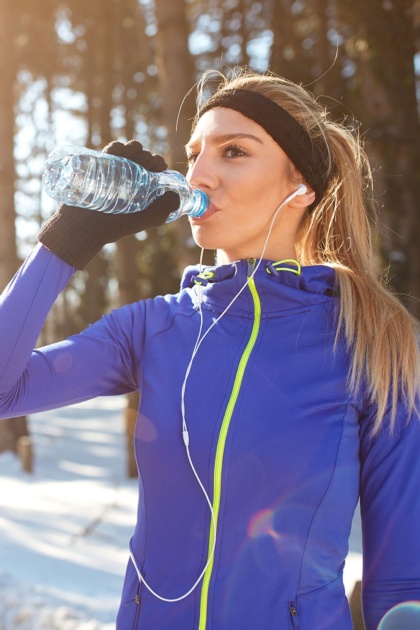
Sports in winter: should you drink less than in summer?
The average body water percentage for an adult is roughly 60% of their body weight. Fluid balance thus plays an important role in the proper functioning of metabolic processes and even losses of a few per-cent are noticeable in one way or another. During athletic endurance training, for example, a fluid loss of around 4% or more will reduce your performance capability and the corresponding fluid intake rec-ommendations therefore aim to keep this loss in check.
In general: drink enough, but not too much
When it comes to nutrition, there are many basic principles. One of them is: you can get too little as well as too much of all the vital substances. Both undercutting the minimum amount necessary for life and exceeding the maximum tolerable quantity will lead to health problems sooner or later. This also applies to water. That is why the motto, which also applies during physical exertion, is: drink enough, but not too much.
The appropriate amount of fluids during sports depends to a large extent on the expected sweat loss. At moderate ambient temperatures, however, the sweat loss range is enormous and varies between 0.2 and 2.0 litres per hour. That is why it is difficult to define a universal recommendation for the ideal amount of fluid intake.
Nevertheless, those seeking an indication can follow the rough drinking recommendation of 0.4 to 0.8 litres per hour of sports. This recommendation, however, is merely a rule of thumb and is not meant to be followed exactly. An ambitious athlete is best off estimating the appropriate fluid intake on an indi-vidual basis, for example, with the help of the hydration calculator on the website of the Swiss Sports Nutrition Society.
Do you sweat less in winter than in summer?
With each muscle movement we release heat, which needs to be removed from the body. We would gradually overheat otherwise, and would need to reduce the exertion or even stop it. To ensure this does not happen, we sweat. This is because sweating and the ensuing evaporation of sweat are very efficient ways of dissipating excess heat.
The direct emission of body heat into the surrounding air is another cooling mechanism. The colder the ambient air, the more heat we can give off in this second way. If we don’t completely cover our bodies with warm clothing in winter, this second way also significantly contributes to cooling our bodies down. And the body then needs to sweat less to achieve the same overall cooling performance. But if we only wear light clothing, the sweat rate on a cold, dry day in comparison to a warm, humid day can be up to one litre less per hour. This means it is not possible to recommend a flat-rate fluid intake for wintry situations and the often-heard saying «it depends on the individual situation» is necessary again.
Do respiratory water losses play a role in winter?
Inhaled air is moistened in the lungs, which is why we lose some fluid in the form of water vapour with each breath. Because cold air is always dry, the wintry air in your lungs is more heavily moistened than in the summer heat and the loss is therefore higher. In very cold temperatures, this fluid loss looks like a small cloud of fog, which we produce with every breath.
At moderate temperatures, the respiratory water loss when resting amounts to around 0.3 litres per day. For intensive training units, you can expect to lose 1 to 2 dL per hour on average. Thus, the overall respiratory water loss during energetic activities lasting a few hours is not particularly high and does not require you to adapt your drinking behaviour accordingly, even when doing normal training units in the cold weather.
Only when undertaking long, protracted energetic activities that last the entire day, such as ski touring, will the respiratory water loss reach significant values of up to an extremely high 2 litres per day. This must then be deliberately counterbalanced after the exertion. If you sweat a lot at the same time, then you will need to increase your fluid intake accordingly during the exertion.
Summed up for use in practice
- In principle, you don't sweat less in winter than in summer.
- Your clothing affects the sweat rate to a great degree and the appropriate fluid intake varies ac-cordingly.
- The fluid recommendation of 0.4 to 0.8 l/h is merely a rule of thumb, which can be roughly adhered to in summer as well as in winter.
- The appropriate fluid intake should ideally be calculated on an individual basis in both summer and winter using the hydration calculator, for example.
Foto:iStock.com
This may be of interest for you too


